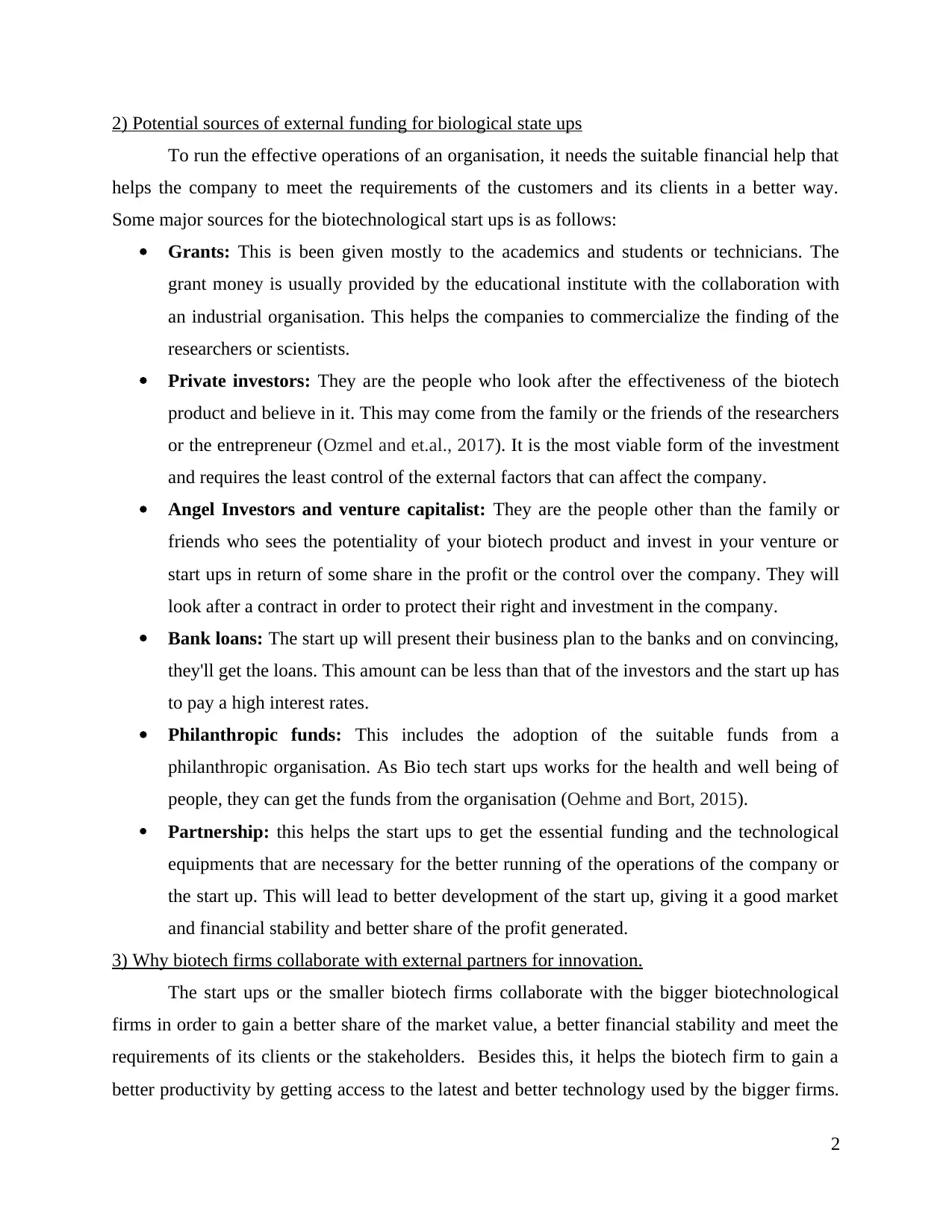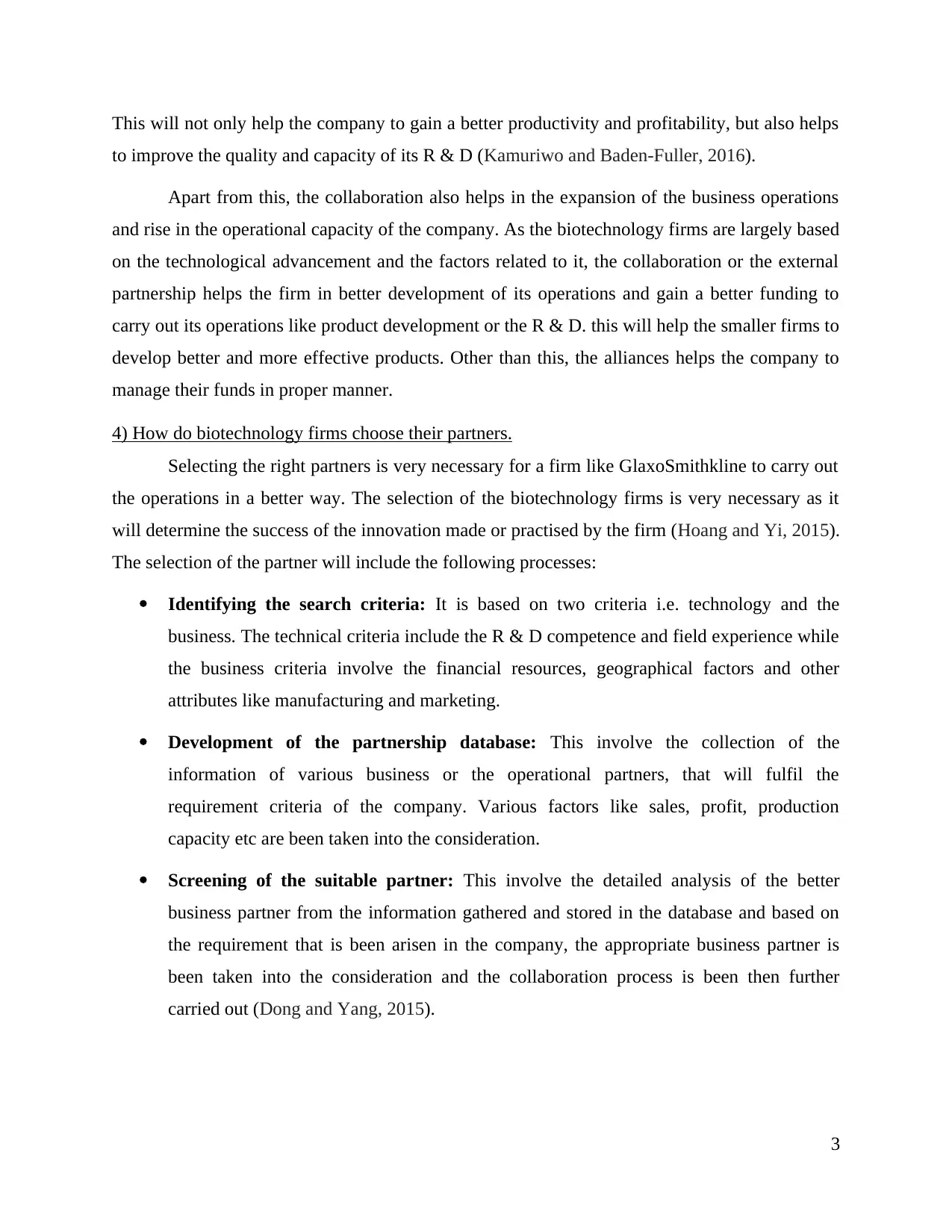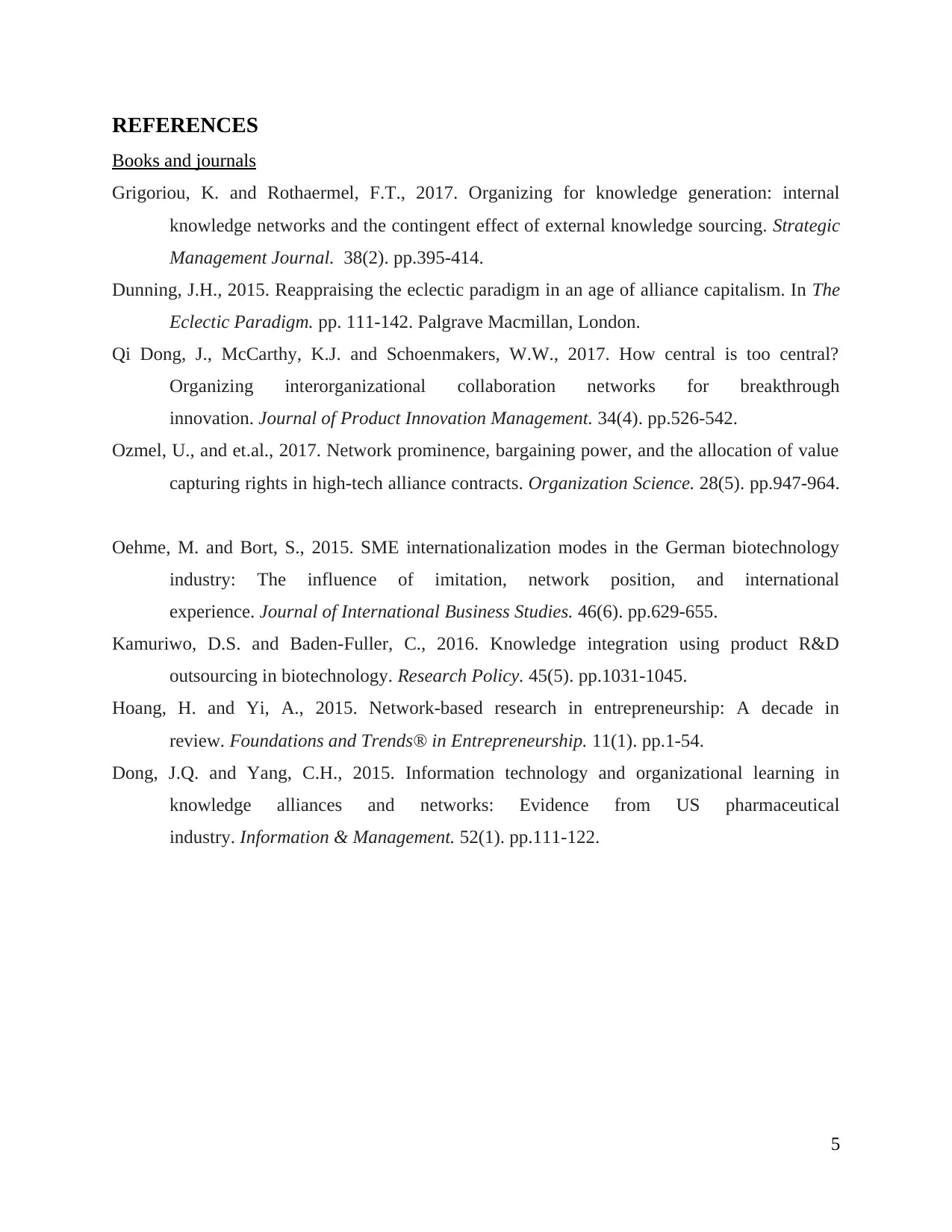Analysis of Networks and Alliances in Biotechnology Industry
VerifiedAdded on 2020/07/22
|7
|1741
|69
Report
AI Summary
This report provides an overview of the biotechnology industry, focusing on its activities, key players, and the significance of networks and alliances. The report begins by describing the biotechnology industry, its largest segments, and key market players, including GlaxoSmithkline. It then explores potential sources of external funding for biotechnology startups, encompassing grants, private investors, venture capitalists, bank loans, philanthropic funds, and partnerships. Furthermore, the report examines the reasons behind biotech firms collaborating with external partners for innovation, highlighting the benefits of accessing technology, expanding market share, and improving R&D capabilities. Finally, the report outlines the processes biotechnology firms use to select their partners, including identifying search criteria, developing a partnership database, and screening potential partners. The report concludes by emphasizing the emerging and alliance-driven nature of the biotechnology sector.

Networks and alliances in
biotechnology
biotechnology
Paraphrase This Document
Need a fresh take? Get an instant paraphrase of this document with our AI Paraphraser

Table of Contents
INTRODUCTION...........................................................................................................................1
1) Describe biotechnology industry, its activities, the largest segment and the key players in
market..........................................................................................................................................1
2) Potential sources of external funding for biological state ups................................................2
3) Why biotech firms collaborate with external partners for innovation....................................2
4) How do biotechnology firms choose their partners................................................................3
CONCLUSION................................................................................................................................4
REFERENCES................................................................................................................................5
INTRODUCTION...........................................................................................................................1
1) Describe biotechnology industry, its activities, the largest segment and the key players in
market..........................................................................................................................................1
2) Potential sources of external funding for biological state ups................................................2
3) Why biotech firms collaborate with external partners for innovation....................................2
4) How do biotechnology firms choose their partners................................................................3
CONCLUSION................................................................................................................................4
REFERENCES................................................................................................................................5

INTRODUCTION
The biotechnology industry is among the one of the youngest in the industrial sector and
is known for the highest number of alliances that are been formed for the development of the
firm (Grigoriou and Rothaermel, 2017). The organisation of context for our report is
GlaxoSmithkline, which works in small molecules, Vaccines and Biologies segment of
biotechnology. This report will cover the activities and key players of this sector with various
sources of funding and collaboration for the innovation process.
1) Describe biotechnology industry, its activities, the largest segment and the key players in
market
The biotechnology is the use of biological living systems and develop the better bio
products using the suitable and appropriate technology. It the use of technological applications
along with the biological system to develop better industrial products. The biotechnology
industry works for the better development of the suitable therapies and the diagnostics that will
help in increase the betterment of the health and well being of the people. It includes the
development of better drugs, medicines, treatments to diseases and other biochemical or
biotechnological products (Dunning, 2015). It includes the various activities or the processes that
are been carried out by a biotech company such as development of the pharmaceutical medicines
and other clinical research services for the medical purposes and improving the quality of the
health and well being in UK, development of better agricultural components to promote the
better agricultural practices and growth of the crops improving the quality of food and living,
manufacturing of the various biological enzymes which are been further used for the
commercialisation and marketing for the medical and non medical purposes and storing of the
biometrics or biological information for the safety and keeping the detailed record of the people.
The largest of all the segments of the biotechnology industry is the pharmaceutical
medicines and vaccinations, biological products and the smaller molecular research and
development which comprises the largest number of employee's and fund generation in UK.
Besides this, it has the highest scope of innovation to be made (Qi Dong, McCarthy and
Schoenmakers, 2017). It works in both, medical and non medical segment of the market and
caters a high number of customers. The major key players in the market of biotechnology are
GlaxoSmithkline, BTG, Indivor etc. which consists of the major market of the biotechnology
industry and generate the maximum number of funding for the biotechnological activities.
1
The biotechnology industry is among the one of the youngest in the industrial sector and
is known for the highest number of alliances that are been formed for the development of the
firm (Grigoriou and Rothaermel, 2017). The organisation of context for our report is
GlaxoSmithkline, which works in small molecules, Vaccines and Biologies segment of
biotechnology. This report will cover the activities and key players of this sector with various
sources of funding and collaboration for the innovation process.
1) Describe biotechnology industry, its activities, the largest segment and the key players in
market
The biotechnology is the use of biological living systems and develop the better bio
products using the suitable and appropriate technology. It the use of technological applications
along with the biological system to develop better industrial products. The biotechnology
industry works for the better development of the suitable therapies and the diagnostics that will
help in increase the betterment of the health and well being of the people. It includes the
development of better drugs, medicines, treatments to diseases and other biochemical or
biotechnological products (Dunning, 2015). It includes the various activities or the processes that
are been carried out by a biotech company such as development of the pharmaceutical medicines
and other clinical research services for the medical purposes and improving the quality of the
health and well being in UK, development of better agricultural components to promote the
better agricultural practices and growth of the crops improving the quality of food and living,
manufacturing of the various biological enzymes which are been further used for the
commercialisation and marketing for the medical and non medical purposes and storing of the
biometrics or biological information for the safety and keeping the detailed record of the people.
The largest of all the segments of the biotechnology industry is the pharmaceutical
medicines and vaccinations, biological products and the smaller molecular research and
development which comprises the largest number of employee's and fund generation in UK.
Besides this, it has the highest scope of innovation to be made (Qi Dong, McCarthy and
Schoenmakers, 2017). It works in both, medical and non medical segment of the market and
caters a high number of customers. The major key players in the market of biotechnology are
GlaxoSmithkline, BTG, Indivor etc. which consists of the major market of the biotechnology
industry and generate the maximum number of funding for the biotechnological activities.
1
⊘ This is a preview!⊘
Do you want full access?
Subscribe today to unlock all pages.

Trusted by 1+ million students worldwide

2) Potential sources of external funding for biological state ups
To run the effective operations of an organisation, it needs the suitable financial help that
helps the company to meet the requirements of the customers and its clients in a better way.
Some major sources for the biotechnological start ups is as follows:
Grants: This is been given mostly to the academics and students or technicians. The
grant money is usually provided by the educational institute with the collaboration with
an industrial organisation. This helps the companies to commercialize the finding of the
researchers or scientists.
Private investors: They are the people who look after the effectiveness of the biotech
product and believe in it. This may come from the family or the friends of the researchers
or the entrepreneur (Ozmel and et.al., 2017). It is the most viable form of the investment
and requires the least control of the external factors that can affect the company.
Angel Investors and venture capitalist: They are the people other than the family or
friends who sees the potentiality of your biotech product and invest in your venture or
start ups in return of some share in the profit or the control over the company. They will
look after a contract in order to protect their right and investment in the company.
Bank loans: The start up will present their business plan to the banks and on convincing,
they'll get the loans. This amount can be less than that of the investors and the start up has
to pay a high interest rates.
Philanthropic funds: This includes the adoption of the suitable funds from a
philanthropic organisation. As Bio tech start ups works for the health and well being of
people, they can get the funds from the organisation (Oehme and Bort, 2015).
Partnership: this helps the start ups to get the essential funding and the technological
equipments that are necessary for the better running of the operations of the company or
the start up. This will lead to better development of the start up, giving it a good market
and financial stability and better share of the profit generated.
3) Why biotech firms collaborate with external partners for innovation.
The start ups or the smaller biotech firms collaborate with the bigger biotechnological
firms in order to gain a better share of the market value, a better financial stability and meet the
requirements of its clients or the stakeholders. Besides this, it helps the biotech firm to gain a
better productivity by getting access to the latest and better technology used by the bigger firms.
2
To run the effective operations of an organisation, it needs the suitable financial help that
helps the company to meet the requirements of the customers and its clients in a better way.
Some major sources for the biotechnological start ups is as follows:
Grants: This is been given mostly to the academics and students or technicians. The
grant money is usually provided by the educational institute with the collaboration with
an industrial organisation. This helps the companies to commercialize the finding of the
researchers or scientists.
Private investors: They are the people who look after the effectiveness of the biotech
product and believe in it. This may come from the family or the friends of the researchers
or the entrepreneur (Ozmel and et.al., 2017). It is the most viable form of the investment
and requires the least control of the external factors that can affect the company.
Angel Investors and venture capitalist: They are the people other than the family or
friends who sees the potentiality of your biotech product and invest in your venture or
start ups in return of some share in the profit or the control over the company. They will
look after a contract in order to protect their right and investment in the company.
Bank loans: The start up will present their business plan to the banks and on convincing,
they'll get the loans. This amount can be less than that of the investors and the start up has
to pay a high interest rates.
Philanthropic funds: This includes the adoption of the suitable funds from a
philanthropic organisation. As Bio tech start ups works for the health and well being of
people, they can get the funds from the organisation (Oehme and Bort, 2015).
Partnership: this helps the start ups to get the essential funding and the technological
equipments that are necessary for the better running of the operations of the company or
the start up. This will lead to better development of the start up, giving it a good market
and financial stability and better share of the profit generated.
3) Why biotech firms collaborate with external partners for innovation.
The start ups or the smaller biotech firms collaborate with the bigger biotechnological
firms in order to gain a better share of the market value, a better financial stability and meet the
requirements of its clients or the stakeholders. Besides this, it helps the biotech firm to gain a
better productivity by getting access to the latest and better technology used by the bigger firms.
2
Paraphrase This Document
Need a fresh take? Get an instant paraphrase of this document with our AI Paraphraser

This will not only help the company to gain a better productivity and profitability, but also helps
to improve the quality and capacity of its R & D (Kamuriwo and Baden-Fuller, 2016).
Apart from this, the collaboration also helps in the expansion of the business operations
and rise in the operational capacity of the company. As the biotechnology firms are largely based
on the technological advancement and the factors related to it, the collaboration or the external
partnership helps the firm in better development of its operations and gain a better funding to
carry out its operations like product development or the R & D. this will help the smaller firms to
develop better and more effective products. Other than this, the alliances helps the company to
manage their funds in proper manner.
4) How do biotechnology firms choose their partners.
Selecting the right partners is very necessary for a firm like GlaxoSmithkline to carry out
the operations in a better way. The selection of the biotechnology firms is very necessary as it
will determine the success of the innovation made or practised by the firm (Hoang and Yi, 2015).
The selection of the partner will include the following processes:
Identifying the search criteria: It is based on two criteria i.e. technology and the
business. The technical criteria include the R & D competence and field experience while
the business criteria involve the financial resources, geographical factors and other
attributes like manufacturing and marketing.
Development of the partnership database: This involve the collection of the
information of various business or the operational partners, that will fulfil the
requirement criteria of the company. Various factors like sales, profit, production
capacity etc are been taken into the consideration.
Screening of the suitable partner: This involve the detailed analysis of the better
business partner from the information gathered and stored in the database and based on
the requirement that is been arisen in the company, the appropriate business partner is
been taken into the consideration and the collaboration process is been then further
carried out (Dong and Yang, 2015).
3
to improve the quality and capacity of its R & D (Kamuriwo and Baden-Fuller, 2016).
Apart from this, the collaboration also helps in the expansion of the business operations
and rise in the operational capacity of the company. As the biotechnology firms are largely based
on the technological advancement and the factors related to it, the collaboration or the external
partnership helps the firm in better development of its operations and gain a better funding to
carry out its operations like product development or the R & D. this will help the smaller firms to
develop better and more effective products. Other than this, the alliances helps the company to
manage their funds in proper manner.
4) How do biotechnology firms choose their partners.
Selecting the right partners is very necessary for a firm like GlaxoSmithkline to carry out
the operations in a better way. The selection of the biotechnology firms is very necessary as it
will determine the success of the innovation made or practised by the firm (Hoang and Yi, 2015).
The selection of the partner will include the following processes:
Identifying the search criteria: It is based on two criteria i.e. technology and the
business. The technical criteria include the R & D competence and field experience while
the business criteria involve the financial resources, geographical factors and other
attributes like manufacturing and marketing.
Development of the partnership database: This involve the collection of the
information of various business or the operational partners, that will fulfil the
requirement criteria of the company. Various factors like sales, profit, production
capacity etc are been taken into the consideration.
Screening of the suitable partner: This involve the detailed analysis of the better
business partner from the information gathered and stored in the database and based on
the requirement that is been arisen in the company, the appropriate business partner is
been taken into the consideration and the collaboration process is been then further
carried out (Dong and Yang, 2015).
3

CONCLUSION
The Biotechnology is one of the emerging and the sector with most number of alliances.
This report covered the details of the biotechnology sector, its activities and key players of this
sector along with the various sources of its funding and collaboration for the innovation process.
Apart from this, the report also focuses on the choice of the innovation partners of the cited firm.
4
The Biotechnology is one of the emerging and the sector with most number of alliances.
This report covered the details of the biotechnology sector, its activities and key players of this
sector along with the various sources of its funding and collaboration for the innovation process.
Apart from this, the report also focuses on the choice of the innovation partners of the cited firm.
4
⊘ This is a preview!⊘
Do you want full access?
Subscribe today to unlock all pages.

Trusted by 1+ million students worldwide

REFERENCES
Books and journals
Grigoriou, K. and Rothaermel, F.T., 2017. Organizing for knowledge generation: internal
knowledge networks and the contingent effect of external knowledge sourcing. Strategic
Management Journal. 38(2). pp.395-414.
Dunning, J.H., 2015. Reappraising the eclectic paradigm in an age of alliance capitalism. In The
Eclectic Paradigm. pp. 111-142. Palgrave Macmillan, London.
Qi Dong, J., McCarthy, K.J. and Schoenmakers, W.W., 2017. How central is too central?
Organizing interorganizational collaboration networks for breakthrough
innovation. Journal of Product Innovation Management. 34(4). pp.526-542.
Ozmel, U., and et.al., 2017. Network prominence, bargaining power, and the allocation of value
capturing rights in high-tech alliance contracts. Organization Science. 28(5). pp.947-964.
Oehme, M. and Bort, S., 2015. SME internationalization modes in the German biotechnology
industry: The influence of imitation, network position, and international
experience. Journal of International Business Studies. 46(6). pp.629-655.
Kamuriwo, D.S. and Baden-Fuller, C., 2016. Knowledge integration using product R&D
outsourcing in biotechnology. Research Policy. 45(5). pp.1031-1045.
Hoang, H. and Yi, A., 2015. Network-based research in entrepreneurship: A decade in
review. Foundations and Trends® in Entrepreneurship. 11(1). pp.1-54.
Dong, J.Q. and Yang, C.H., 2015. Information technology and organizational learning in
knowledge alliances and networks: Evidence from US pharmaceutical
industry. Information & Management. 52(1). pp.111-122.
5
Books and journals
Grigoriou, K. and Rothaermel, F.T., 2017. Organizing for knowledge generation: internal
knowledge networks and the contingent effect of external knowledge sourcing. Strategic
Management Journal. 38(2). pp.395-414.
Dunning, J.H., 2015. Reappraising the eclectic paradigm in an age of alliance capitalism. In The
Eclectic Paradigm. pp. 111-142. Palgrave Macmillan, London.
Qi Dong, J., McCarthy, K.J. and Schoenmakers, W.W., 2017. How central is too central?
Organizing interorganizational collaboration networks for breakthrough
innovation. Journal of Product Innovation Management. 34(4). pp.526-542.
Ozmel, U., and et.al., 2017. Network prominence, bargaining power, and the allocation of value
capturing rights in high-tech alliance contracts. Organization Science. 28(5). pp.947-964.
Oehme, M. and Bort, S., 2015. SME internationalization modes in the German biotechnology
industry: The influence of imitation, network position, and international
experience. Journal of International Business Studies. 46(6). pp.629-655.
Kamuriwo, D.S. and Baden-Fuller, C., 2016. Knowledge integration using product R&D
outsourcing in biotechnology. Research Policy. 45(5). pp.1031-1045.
Hoang, H. and Yi, A., 2015. Network-based research in entrepreneurship: A decade in
review. Foundations and Trends® in Entrepreneurship. 11(1). pp.1-54.
Dong, J.Q. and Yang, C.H., 2015. Information technology and organizational learning in
knowledge alliances and networks: Evidence from US pharmaceutical
industry. Information & Management. 52(1). pp.111-122.
5
1 out of 7
Related Documents
Your All-in-One AI-Powered Toolkit for Academic Success.
+13062052269
info@desklib.com
Available 24*7 on WhatsApp / Email
![[object Object]](/_next/static/media/star-bottom.7253800d.svg)
Unlock your academic potential
Copyright © 2020–2025 A2Z Services. All Rights Reserved. Developed and managed by ZUCOL.




